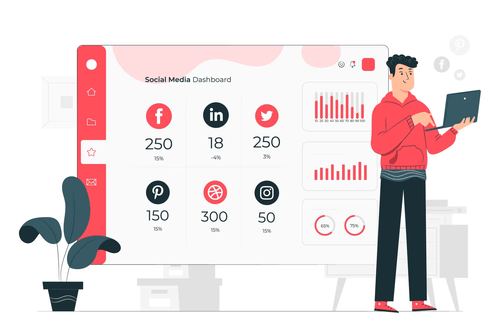Social media is everywhere and certainly won’t be going away any time soon. If you’re looking to move on from just having someone in the office post just to have something and instead move on to having a professional and effective social media presence this guide is for you!

In today’s world, it’s difficult to imagine running a successful business without an online presence. Social media platforms have become a vital part of this online presence. With over 4.2 billion active social media users worldwide, it’s clear that social media is an essential aspect of digital marketing. Therefore, having a well-planned social media strategy is vital to achieving your marketing objectives. In this article, we’ll discuss why you need a social media strategy and its benefits.
Why You Need a Social Media Strategy

Benefits of a Strong Social Media Strategy
Having a social media strategy ensures that your efforts are aligned with your overall marketing objectives. Without a strategy, your social media activity may be sporadic and haphazard, leading to a lack of consistency in messaging and branding. This can lead to confusion for your audience and undermine your efforts. By having a strategy, you can define your goals, target audience, messaging, and content, ensuring that all your activities are focused and aligned.
Social media can move very fast and you may have to change some aspects on short notice to take advantage of new opportunities. A social media strategy allows you to measure your success and adjust your approach accordingly. You can use metrics like engagement rates, click-through rates, and conversion rates to track your progress and make data-driven decisions to optimize your strategy. This way, you can identify what’s working and what’s not, make improvements, and continually refine your approach to achieve your marketing objectives.
A social media strategy enables you to reach and engage with your target audience effectively. You can use social media platforms to create a community around your brand, engage in conversations, and build relationships with your audience. By doing so, you can increase brand awareness, loyalty, and advocacy, leading to increased customer retention and acquisition.
Do We Need An Expert?
While it’s true that anyone can create a social media account and start posting, there’s a significant difference between having an office worker posting part-time and having a professional, planned campaign. Investing in a professional social media campaign can yield impressive results, while a part-time posting approach can hinder your efforts.
Getting the most from your social media marketing requires a thorough understanding of the platforms, their algorithms, and the best practices for content creation and distribution. A professional marketing agency will have the experience and expertise to navigate these complexities, ensuring that your content is optimized for each platform and that your posts are seen by your target audience. This means that your posts are more likely to generate engagement, reach, and followers than a part-time posting approach and this leads directly to more sales.
Posting sporadically without a clear strategy or plan can lead to confusion for your audience, resulting in reduced engagement and less impact. A professional marketing agency will work with you to create a comprehensive social media strategy that aligns with your marketing objectives, defines your target audience, outlines your content themes, and establishes a posting schedule. This way, your social media activity is consistent and strategic, leading to increased engagement and a stronger online presence.
A professional social media campaign requires creativity and originality. To stand out on social media, your content needs to be fresh, engaging, and shareable. A professional marketing agency can provide you with creative ideas, high-quality visuals, and engaging copy that resonates with your audience. This way, your content is more likely to be shared, increasing your reach and potential impact.
One case study that illustrates the difference between a professional social media campaign and a part-time posting approach is that of the UK-based restaurant chain, Leon. Leon was struggling to generate engagement on their social media platforms, with low levels of followers and limited reach. They had been using a part-time posting approach, with no clear strategy or plan. Leon enlisted the help of a professional marketing agency, who worked with them to create a comprehensive social media strategy. The agency helped Leon to define their target audience, establish a consistent posting schedule, and create engaging content. As a result, Leon’s social media presence grew significantly, with a 138% increase in followers on Instagram and a 550% increase in reach on Facebook (Zazzle Media, 2021).
Another example of a brand that benefited from a professional social media campaign is that of the UK-based fashion brand, ASOS. ASOS worked with a professional marketing agency to create a comprehensive social media strategy that included influencer partnerships, user-generated content, and social media advertising. As a result, ASOS’s social media presence grew significantly, with over 20 million Instagram followers and a 36% increase in revenue (Sprout Social, 2021).
How Social Media Improves Sales

Social media platforms are more than just a way to interact with your audience and build brand awareness. They are a powerful tool for lead generation and driving sales for both service businesses and ecommerce businesses. By using social media strategically, you can not only attract potential customers but also convert them into loyal buyers.
According to Hubspot, companies that use social media for lead generation see a 24% increase in revenue. Social media is an excellent platform to attract leads because it allows you to target your audience with precision. With advanced targeting options, you can identify potential customers based on their interests, demographics, and even behaviors.
For service-based businesses, social media can help drive sales by attracting potential clients to your website or landing pages. Through targeted advertising, social media can generate leads by directing potential clients to specific services and offerings that meet their needs. For example, a financial advisor could use social media to promote their services to people who have recently searched for “financial planning” or “retirement savings.”
Ecommerce businesses can also benefit from a strategic social media campaign. Social media platforms like Instagram and Facebook have advanced shopping features that make it easy for customers to make purchases directly from their feeds. With over 70% of shoppers using social media to research products before making a purchase, it’s clear that a well-executed social media strategy can be a game-changer for ecommerce businesses.
One example is pet food company, Lily’s Kitchen. Through targeted social media advertising, they were able to achieve a 31% increase in revenue year-on-year. By promoting their products to dog and cat owners, Lily’s Kitchen was able to attract and convert new customers who were already in the market for high-quality pet food.
How To Create A Social Media Strategy
Setting Goals

When setting goals for your social media campaign, it is crucial to align them with your overall marketing strategy. Your social media goals should reflect your business’s broader objectives, such as increasing brand awareness, generating leads, and driving sales. Here are some tips to help you decide on goals for your social media campaign:
- Determine your target audience: Knowing who your target audience is will help you set appropriate goals for your social media campaign. Your goals should reflect your audience’s preferences, behaviours, and needs.
- Conduct a social media audit: Conduct a social media audit to identify your strengths and weaknesses in your social media presence. This will help you determine areas that require improvement and what goals to set to improve your social media presence.
- Evaluate your competition: Research your competitors’ social media activities to see what works and what doesn’t. This information will help you set goals that can give you a competitive advantage.
Typical goals for a social media campaign include:
- Increasing brand awareness: This goal is about building brand recognition and making your brand more visible on social media. You can achieve this goal by increasing your followers, likes, comments, shares, and other engagement metrics.
- Generating leads: This goal involves using social media to attract potential customers to your business. You can achieve this goal by creating engaging content that encourages your followers to share their contact information or visit your website.
- Driving sales: This goal involves using social media to convert your followers into paying customers. You can achieve this goal by creating content that promotes your products or services and providing incentives for your followers to make purchases.
Once you have set your social media goals, it is crucial to set targets to measure your success. Here are some tips to help you set targets:
- Use specific metrics: Set targets based on specific metrics, such as the number of followers, likes, comments, shares, website visits, and sales.
- Set realistic targets: Set targets that are achievable but challenging. Setting unattainable targets can demotivate you and your team.
- Track your progress: Regularly monitor and evaluate your progress towards your targets. This will help you make adjustments to your social media campaign to ensure you meet your goals.
Choosing Which Social Media Platforms To Use
When it comes to social media marketing, choosing the right platform is crucial for the success of your campaign. It is important to consider several factors such as your company’s goals, target audience, the size of your existing audience, and the effectiveness of each platform for your business. Additionally, you need to understand what types of media formats work best on different platforms and how they can play a role in choosing the right social media channels for your campaign.
Consider Your Goals and Type of Company
Before deciding on which social media channels to use for your campaign, you need to consider your goals and the type of company you have. Are you trying to generate leads, increase sales, or build brand awareness? Each social media platform has different strengths and weaknesses and may be better suited for certain types of goals.
For example, if you are a B2B company looking to generate leads, LinkedIn may be the ideal platform for you. With over 722 million members, LinkedIn is the largest professional networking site and can help you connect with potential clients, partners, and employees. On the other hand, if you are a B2C company looking to build brand awareness and connect with your audience on a more personal level, Instagram may be the right choice for you.
Understand Your Target Audience and Existing Audience Size
Understanding your target audience and the size of your existing audience is also important when choosing the right social media channels for your campaign. Each platform has a different demographic and user base, and you want to make sure that you are reaching the right people with your content.
For example, if your target audience is millennials or Gen Z, TikTok may be a good platform to consider. With over 689 million active users, the majority of whom are under 30 years old, TikTok can help you connect with a younger audience and showcase your brand’s personality. However, if your target audience is primarily middle-aged or older professionals, LinkedIn or Facebook may be a better choice.
In addition, you should also consider the size of your existing audience on each platform. If you have a large following on Instagram, it may be more beneficial to focus your efforts on that platform and build on your existing audience rather than starting from scratch on a new platform.
Assess the Effectiveness of Each Platform for Your Business
The effectiveness of each social media platform for your business is another crucial factor to consider. While a platform may have a large user base and seem like a good fit, it may not be effective for your specific business needs.
For example, if you are a fashion brand looking to showcase your products, Instagram may be an effective platform for you. With its visual nature, Instagram allows you to showcase your products in a visually appealing way and connect with your audience through influencers and user-generated content. On the other hand, if you are a law firm or a financial services company, Twitter or LinkedIn may be more effective platforms for you as they allow you to share industry news, insights, and connect with potential clients in a more professional setting.
Understand What Media Formats Work Best on Different Platforms
Understanding what types of media formats work best on different platforms is also important when choosing the right social media channels for your campaign. Each platform has a different format that works best, and you want to make sure that you are creating content that resonates with your audience on each platform.
For example, on Instagram, visually appealing images and short videos work best. Instagram Stories and Reels are also great ways to showcase your brand’s personality and connect with your audience. On Twitter, short and snappy tweets, infographics, and video clips work best. On LinkedIn, long-form posts, industry news, and thought leadership content perform well.
Content Calendars

Creating a social media content calendar can be an incredibly useful tool for businesses looking to develop and maintain a successful social media presence. It enables you to plan ahead and schedule your social media posts in advance, ensuring that you always have a consistent flow of content that aligns with your overall marketing strategy.
What is a social media content calendar?
A social media content calendar is a document that outlines the content you plan to publish on your social media platforms over a specified period of time. It can be in the form of a spreadsheet, a calendar, or any other format that suits your needs. Your content calendar should include details such as the date and time of each post, the social media platform on which it will be published, the type of content (e.g. image, video, text), and any relevant hashtags or captions.
What is it used for?
One of the primary uses of a social media content calendar is to help you plan and organise your content creation and sign off schedules. It can be difficult to keep track of all the content you need to produce, especially if you are publishing across multiple platforms. A content calendar provides you with a clear overview of all the content you need to create and publish, allowing you to manage your time more efficiently and ensure that everything is completed on schedule.
Another important use of a social media content calendar is to help you align your social media content with your overall marketing strategy. By planning your content in advance, you can ensure that your social media posts are consistent with your brand message and objectives. This is essential for building a strong brand identity and maintaining a cohesive presence across all your social media channels.
Benefits of a social media content calendar
There are several benefits to using a social media content calendar. By planning and scheduling your content in advance, you can avoid the last-minute rush to create and publish posts. This can be especially helpful if you have a small team or limited resources, as it allows you to maximise your efficiency and focus on other areas of your business.
Consistency is key when it comes to social media, as it helps to build trust and credibility with your audience. By having a schedule in place, you can ensure that you always have a regular flow of content going out to your followers.
A social media content calendar can help you to stay organised. It provides you with a clear overview of your content plan, allowing you to see at a glance what needs to be done and when. This can be especially helpful if you are managing multiple social media accounts or collaborating with a team of content creators.
Continuous Improvement
Analysing Your Campaign

Once your campaign is live, it’s crucial to keep an eye on its progress and analyze its performance to ensure its success. In this section, we’ll cover the importance of using analytics to measure your campaign’s success and how to use this information to improve your current campaign and future campaigns.
Analytics play a significant role in measuring the success of a social media campaign. They provide valuable insights into audience behavior and engagement, allowing you to understand how well your content is performing and whether it’s resonating with your target audience. With this information, you can refine your campaign and optimize your content to achieve better results.
To begin, you’ll need to define your key performance indicators (KPIs) before the campaign launches. KPIs are metrics that measure the success of your campaign, such as likes, comments, shares, click-through rates (CTRs), and conversions. By identifying your KPIs, you can focus on the metrics that matter most and track your progress against your goals.
Once your campaign is live, you can start collecting data and analyzing your KPIs. The easiest way to access this data is through the analytics tools provided by each social media platform. For example, Facebook Insights, Twitter Analytics, and Instagram Insights offer detailed reports on your content’s performance, audience demographics, and engagement metrics.
When analyzing your data, look for patterns and trends that could inform your strategy. For instance, you might notice that certain types of content perform better than others or that specific times of day generate higher engagement rates. Use this information to optimize your content and posting schedule.
Another way to use analytics is to A/B test your content. A/B testing involves creating two versions of the same content and comparing their performance against your KPIs. For example, you could create two versions of an Instagram post with different captions or images and see which one generates more engagement. Use the insights you gain from A/B testing to optimize your content and refine your strategy.
In addition to using analytics to improve your current campaign, you can also use this information to inform your future campaigns. By analyzing the data from your past campaigns, you can identify trends and insights that can inform your strategy going forward. For example, you might notice that certain types of content perform better during certain seasons or that your audience engages more with certain topics. Use this information to inform your content strategy for future campaigns.
Finally, it’s important to set aside time to regularly review and analyze your campaign’s performance. Whether it’s weekly, monthly, or quarterly, make sure to schedule time to assess your progress against your KPIs and adjust your strategy as needed. By doing so, you’ll ensure that your campaigns are continually improving and delivering the results you need.

